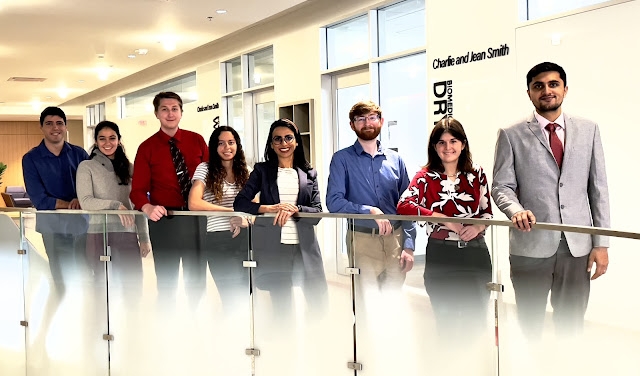
Photo: Student research opportunities are boundless in the Gallogly College of Engineering. OU Assistant Professor Sepideh Razavi’s team includes, from left, Elton Lima Corriea, Aanahita Treaty Irani Ervin, Matthew Webb, Eduarda Barros De Oliveira, Razavi, Nick Brown, Emma Shields and Siddharth Thakur.
At the start of the pandemic, University of Oklahoma researcher Sepideh Razavi remembers people frantically wiping down groceries, cleaning food packaging and sanitizing every surface possible.
Since then, the Food and Drug Administration has emphasized there is no real risk of getting the coronavirus that way (called fomite transmission). Razavi, an assistant professor in the School of Chemical, Biological and Materials Engineering in the Gallogly College of Engineering, uses this example though to explain the importance of droplet wetting – how drops of fluids bead up or spread out when they come in contact with a surface. Dynamics of droplet wetting and spreading is not only important in disease transmission but is also central to industrial processes, including cooling of reactors, emerging technologies such as 3D printing, and commercial applications such as agricultural, pharmaceutical and cosmetics.
Liquid droplet wetting and spreading on a solid substrate is not a new problem and has been studied since the 1800s, Razavi says. “However, in many current applications we are not dealing with a droplet of a simple fluid but rather a complex fluid. You can think of it as a multicomponent solution composed of fluids, ions, molecules, nanoparticles, biomolecules and other constituents.”
Understanding of the wetting behavior and spreading dynamics in such complex systems is limited. For years, industries did trial and error and empirically arrived at a formula, such as application of surfactants in consumer-care products. The same can be true of formulas in inkjet printing. A key challenge in these applications is a precise control over parameters governing the spreading dynamics and evaporation.
Additionally, droplets come in contact with different surfaces. “So, not only the properties of the droplet are important in determining the physics at play, but also the characteristics of the surface onto which it is landing. We ask what are the characteristics of that surface? Is it soft like skin, or is it hard, like a dental surface? Is it smooth or does it have a texture? And then we ask how these characteristics affect the droplet wetting behavior and spreading dynamics,” Razavi said.
Gaining a foundational understanding in this area is not only useful for an engineered design in applications but critical for addressing challenges in energy, water and environmental sustainability sectors, Razavi says. “For example, mitigating negative effects of emerging water contaminants, such as personal care products, nanoparticles, microplastics and antibiotics, requires knowledge on the interactions of water with these components, with other fluids, and at material interfaces,” she said.
Another example is the climate change crisis and the promise of hydrogen as a carbon-free source of energy that could contribute to the fulfillment of the global increase in future energy demands. However, one major challenge facing a hydrogen-based energy economy is the successful subsurface storage of hydrogen in geological formations, which requires an increased understanding of the fluid behavior in a heterogeneous rock and mixed wettability fractures.
The problem of liquid droplet wetting and spreading on a solid substrate is also crucial in scenarios involving biological fluids. “Understanding the behavior of biofluids drops on solid surfaces is a critical step toward solving problems related to human health, such as preventing disease transmissions by virus-loaded droplets. This is where basic research needs to be carried out to provide the transformative fundamental science necessary to underpin novel solutions,” Razavi said.
For her research, Razavi received a National Science Foundation Faculty Early Career Development (CAREER) award for her project titled “Decoding the dynamics of complex fluids near surfaces and interfaces.” The $551,577 award will provide five years of funding to support her work to advance our understanding in wetting, spreading and evaporation of multi-component fluidic droplets on different surfaces. Part of the funds also is allocated to outreach activities.
The project’s outreach component involves several areas, with a focus on promoting the participation and advancement of women in science and engineering. Razavi will work with middle school girls involved in the Engineering Pathways program in the Gallogly College of Engineering. She will also collaborate with the Oklahoma Museum Network on its Women in Science Conference to engage students in science activities.
Outreach also includes targeting women veterans. Oklahoma is home to more than 30,000 women veterans, she says. “I hope to engage women veterans and tribal female veterans in science and inspire them to pursue higher education and join the STEM workforce as they transition to civilian life.”
Razavi earned a doctoral degree in chemical engineering from The City College of New York, followed by a postdoctoral fellowship at the University of Michigan. She joined OU in 2018. The CAREER award is the NSF’s most prestigious honor in support of early-career faculty members who have the potential to serve as academic role models in research and education and to lead advances in the mission of their school or college.
“It is rare for faculty members to receive NSF funding the first time they apply for it,” said Brian Grady, director of the School of Chemical, Biological and Materials Engineering. “I’m extremely proud to have Dr. Razavi as part of this school.”
For more information about the Gallogly College of Engineering at the University of Oklahoma, visit ou.edu/coe.